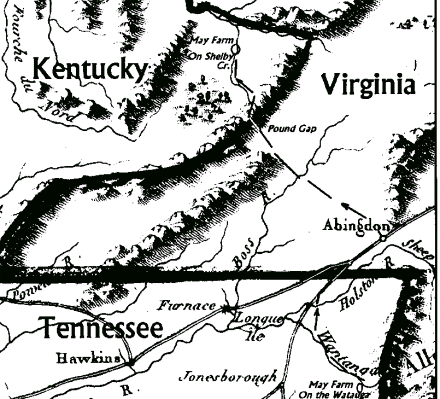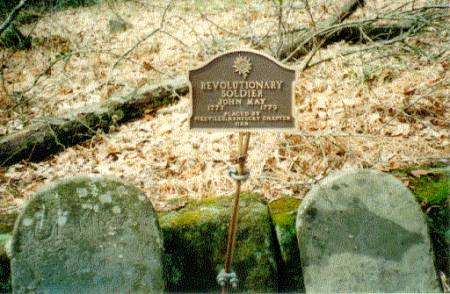|
Floyd County 1800-1848 Return to Index of John May essays Continue with a series of essays on the children of John and Sarah May The first records of families settling in the Big Sandy Valley of Eastern Kentucky date from about 1789. However, very little growth occurred during the following decade. In the autumn of 1800, John and Sarah May moved from the Watauga Valley in Tennessee - their home for the previous eleven years - to remote and sparsely settled Shelby Creek in the upper region of the Big Sandy Valley. The trail the Mays traveled to Kentucky went north from the Watauga - returning along the same route they had traveled in 1789, from Abingdon, Virginia - and then turned west towards Pound Gap in the Cumberland Mountains. After crossing the gap into Floyd County, they continued north into the upper reaches of the Kentucky River Valley. Within a few more miles, they entered the rugged valley of Elkhorn Creek and proceeded towards Shelby Gap, the pass into the headwaters of Shelby Creek. The final segment of the long journey went down the creek to within about two miles of its confluence with the Big Sandy River. The following map shows the approximate route the Mays took through Abingdon, Virginia from their farm on the Watauga to their new homestead on Shelby Creek, a total distance of approximately 150 miles.
Perhaps after their crops were in the barns, John and some of his Watauga friends had made a journey to Kentucky the previous winter to see what prospects were available in the Big Sandy. They may have even built some temporary cabins to house their families when they arrived. Exactly when or how John obtained possession of his first land in Floyd County isn't known. The county was formed only a few months prior to his arrival, and he probably delayed filing a deed until after the new seat of justice was officially established at Prestonsburg. Unfortunately, the early land records of Floyd County for the years dating from 1800 were destroyed when the courthouse burned in 1808. Earlier land records of the Big Sandy - at least to the extent any were ever filed - were recorded at Washington, the county seat of Mason County, over two hundred miles from John's property on Shelby. Shelby Creek was significantly different from the previous
places where the May family had lived. For example, the "Great
Waggon Road," serving thousands of travelers bound for
the southwest, ran through the region of Virginia near the Potomac
River where the Mays lived until 1789. In the 1790s on the Watauga,
John and Sarah had enjoyed modest conveniences such as regular
mail service, flour and corn mills, iron foundries and powder
mills. Throughout the preceding twenty years of their marriage,
the Mays had the luxury of wheat bread on Sundays and special
occasions, John could barter for iron farm tools to cultivate
his fields and he had a dependable source of powder for his longrifle.
Such conveniences wouldn't exist in Floyd County. Despite the many hardships they knew they would face, John and Sarah May were drawn to this new Kentucky frontier by the prospect of unsettled land - affordable acreage for those willing to clear the dense hardwood forests for "new-ground" to grow their crops and pasture their livestock. Only a few families preceded the Mays into the Valley. The May name was destined to become one of the best known in the region, and to this day many descendants of John and Sarah continue to call Eastern Kentucky their home. Settling the Big Sandy Valley
Floyd County - an area of over 3,600 square miles of wilderness that occupied most of present-day Eastern Kentucky - was named in honor of Colonel John Floyd, a famous surveyor, legislator, Indian fighter, and distinguished Kentucky pioneer who died in an Indian ambush in 1783. When it was formed in 1800, Scalf estimates the population of the county at about 478 persons. However, the number of settlers in this region wasn't officially recorded until the U.S. census of 1810, showing an official count of 3,485 inhabitants. In 1800, Lexington, Kentucky, "the rising town of the West," had a population of 2,400 people and boasted the first regular institution of learning west of the Appalachians, Transylvania Seminary. At the time, there was practically no commerce between Eastern and Central Kentucky. No wagon roads yet connected these two regions of the state. Decades after the first settlements were established in the Big Sandy Valley the remote farmers received manufactured goods by packtrains of horses and mules over the mountains from Virginia or by boats from settlements along the Ohio River. Living on Shelby Creek The two older May sons, choosing to pursue their own dreams, soon left their home on Shelby. On February 10, 1802, John May (Jr.) married Mary Catherine (Caty) Hanson in Carter County, Tennessee. We don't know if John, Sr. returned with his son for the wedding, but he did sign the wedding bond. Samuel May, John's second oldest son, settled in Prestonsburg about 1803. On May 8, 1808, twenty-four year-old Samuel married Catherine Evans, and two years later he was listed as the head of a household in the 1810 U. S. Census of Floyd County. In 1845, Samuel wrote, "It has been 41 or 42 years since I was in the company of my father any worth notice and it has been 32 years since his death." Apparently, Samuel only saw his parents on their infrequent visits down the Big Sandy to transact business or appear in County Court in Prestonsburg. The departure of John May's two oldest sons from the farm within three years of their arrival in Kentucky left Thomas as the oldest son to help his father establish a permanent home for the remaining family members. In February of 1803, Thomas celebrated his sixteenth birthday and Daniel, the next youngest son, was about twelve that year. John and Sarah's eighth and last child, Phillip Pollard, was born on Shelby Creek on July 26, 1805. Family tradition says Pollard was the family name of Sarah's mother. Other records say that he he was named Tlepolard and sometimes used the name Tilpollard.
We only have a few records to document the activities of John and Sarah during the period between their arrival on Shelby Creek in 1800 and John's death in 1813. John wrote a brief explanation of the naming of his youngest child, Tlepolard, who was born in 1805. A written receipt, dated October 11, 1811, from J. Mayo for John's 1810 "Revenue tax" still exists. Another record mentions a lawsuit - the complaint was not identified - that was filed by Richard Damron against John May and was appealed in the 1809 August session of the Floyd County Court. In the November 1809 session, a Justice of the Peace, Robert Haws, ruled, "Motion to dismiss overruled ... Plaintiff to recover costs." Sarah, who evidently wasn't the silent type, disputed the
ruling, and a campaign of words against Justice Haws ensued.
He responded with a suit of his own against John and Sarah, saying,
"Sarah, or Sally May, had wickedly uttered malicious
gossip and scandalous words about his rendering a false judgment."
In July of 1810, Sarah was found innocent of Haws' charges, and
he was ordered to "pay the costs above their defense
herein expended." For thirty-five years after John died, Sarah May never remarried
and apparently lived in the home of her son Thomas. Only a few
surviving court records mention her. Soon after John's death,
in March, 1813, the will of William Justice, deceased, was, "proven
by the oaths of Sarah May and Elijah Adkins." On May
24, 1813, Sarah won an appeal judgment against Corban Thomson
in court, but the issues of the case are unknown. It most likely
was a dispute over land. On September 15, 1845, Sarah, at the age of 86, filed her declaration for a Revolutionary War pension at the Pike County courthouse. Since she was probably living was living with Thomas at his home on Robinson Creek in Shelby Valley, Pikeville was the appropriate place for her to file. No record of Sarah's death is extant, but May genealogists have assumed that she died about 1846. A closer study of the record indicates that she was still living in 1848. A brief letter, written by Richard French of the U. S. House of Representatives on January 19, 1848, refers to a request he had received from Sarah May "to ask the Congress of the United States to grant her a pension." Sarah isn't listed in the 1850 Census as a member of the households of either Thomas or Samuel, her only children still living in the valley. It is reasonable to assume that she died sometime between January of 1848 and the date the census was taken on Shelby in 1850. Final Resting Place
|
||||||||||||||||||


